
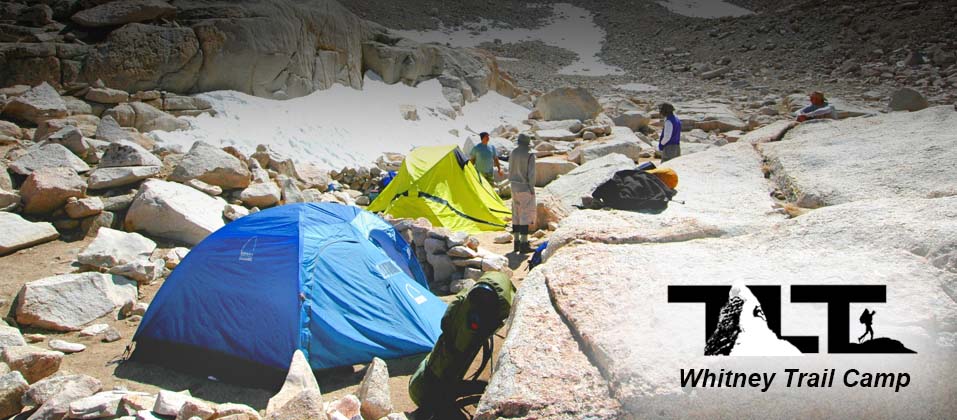 MT WHITNEY TRAIL CAMP - or High Camp (shown above) is one crowded location during peak season. It is located 6.0 miles from the trailhead and resides at 12,000 feet of elevation. Most overnighters use this camp as the stopping point before going on to the summit in the morning. Always camp at least 100 feet from any water source. This rule also applies to how far you must camp from the main trail. Violation of this regulation could put you in a position of being fined and/or create a situation where an Inyo Forest Ranger (who are often stationed somewhere in the area) will have to ask you to relocate your camp.
MT WHITNEY TRAIL CAMP - or High Camp (shown above) is one crowded location during peak season. It is located 6.0 miles from the trailhead and resides at 12,000 feet of elevation. Most overnighters use this camp as the stopping point before going on to the summit in the morning. Always camp at least 100 feet from any water source. This rule also applies to how far you must camp from the main trail. Violation of this regulation could put you in a position of being fined and/or create a situation where an Inyo Forest Ranger (who are often stationed somewhere in the area) will have to ask you to relocate your camp. 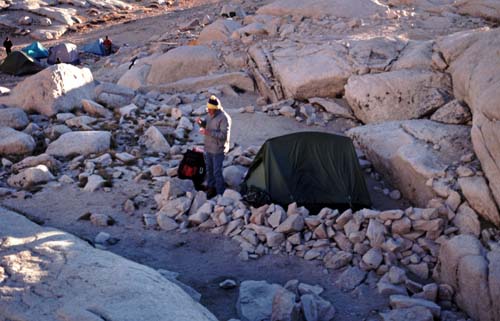 Trail Camp has many established campsites, and there is certainly no need to recreate the wheel when it comes to finding a location for your tent or bivy bag. As you can see in the photo to the right (and in the, main photo above), nice flat campsites are scattered everywhere.
Trail Camp has many established campsites, and there is certainly no need to recreate the wheel when it comes to finding a location for your tent or bivy bag. As you can see in the photo to the right (and in the, main photo above), nice flat campsites are scattered everywhere.Most even have rock walls built around them to block the wind. So, if you cannot find a site nearby,try scrambling a little further up the rocks to the south of the main trail. There are many sites hidden in the surrounding areas, and a little exploring is often all it takes to find a good site if things are crowded when first get there.
When you first arrive at High Camp, try and avoid just setting up your tent and then crashing inside. Even though you may be tired, it is best to stay active. Inactivity can intensify the effects of Altitude Sickness, and at 12,000 feet, most people feel it's effect. Doing camp chores like unpacking, preparing lunch or dinner, and especially taking short walks (during daylight hours) can really help alleviate altitude sickness. Also, when setting up your tent do not forget the rain fly. Not only does this extra layer protect you from unexpected rain during the night, but it also provides an extra layer of warmth to help reduce Hypothermic Conditions. We had clear sunny skies in June 2007, but even so, night time temperatures at Trail Camp ended up being well below freezing.
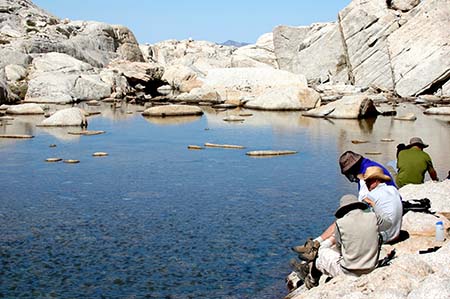 Trail Camp is also the last reliable source of water. The area has a beautiful little tarn (a tarns a small high alpine lake) that provided a perfect place to get water. The photo to the left above shows this nice little Trial Camp Tarn. But as is the case at Outpost Camp, you will need to treat your water by filtering it, boiling it, chemically treating it, or a combination of all the above.
Trail Camp is also the last reliable source of water. The area has a beautiful little tarn (a tarns a small high alpine lake) that provided a perfect place to get water. The photo to the left above shows this nice little Trial Camp Tarn. But as is the case at Outpost Camp, you will need to treat your water by filtering it, boiling it, chemically treating it, or a combination of all the above.These days, with the sheer volume of visitors to the Whitney area, all water must be treated as suspect. For much more on this subject, please check out or write-up on Water/Dehydration.
Trail Camp as you can see, has very little soil, and the terrain is nearly all hard granite rock. For this reason (along with the sheer volume of visitors), all solid human waste must be packed out. The forest service provides poop kits at the Ranger Station for free when you pick up your permit. The bag includes everything you need to get the job done. It even comes with toilet paper and a sanitary wipe for your convenience. Once done, the bag closes up very securely, and there is little chance of spillage in your pack during the transport out. Make sure you observe this regulation, because if people fail to be responsible in this matter, the Forest Service may be forced to impose even stricter limitations on who is able to enter the Whitney Zone.
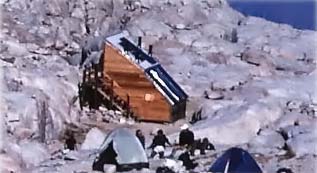 Many Whitney Old Timers may remember the fantastic solar latrine that was located at trail camp. The photo to the right above shows this facility back in 1996. I have to say having this amenity at Trail Camp was deluxe in the past, but it is unfortunately no longer there.
Many Whitney Old Timers may remember the fantastic solar latrine that was located at trail camp. The photo to the right above shows this facility back in 1996. I have to say having this amenity at Trail Camp was deluxe in the past, but it is unfortunately no longer there.Too many people abused the privilege of having a convenient bathroom facility by putting their trash down the toilets which created a mess for those who had to maintain the structure. Because of this, there are no longer any toilets, solar latrines, or outhouses on Mt Whitney.
Next, make sure to secure all your gear before leaving for the summit. Late afternoon thunderstorms can come up at any time. A friend of mine told me that a storm broke out while his group was on the summit. When they finally got back to camp, they found all their gear, including their down sleeping bags, soaked. Needless to say they were forced to exit the mountain in the rain, carrying their water logged gear in the dark. A normally pleasant experience had quickly turned into an exercise in survival as a result of not protecting their equipment. So remember, protect your gear at all times. The day may start out sunny and clear but that does not mean it will stay that way.
As warned by the signs at the Trailhead, weather can change very quickly in the mountains. Thankfully, the group all made it down without injury. Placing your sleeping bag and other items that you do not want to get wet inside your tent is a good way to protect them should a storm come up. Make sure your tents rain fly is in place.
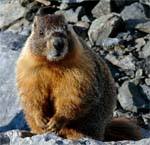 Another important item to pay attention to when securing your site (while you are away) is making sure that your food and scented items are safely stored away in your portable-bear box (a requirement on Whitney). At Trail Camp it is not the bears that will likely be a problem, but the pesky other little critters that populate the area. Pika's (small chipmunk like animals), birds, and especially marmots are always on the prowl and they have no problem chewing through your tent or pack if they detect food or scented items inside.
Another important item to pay attention to when securing your site (while you are away) is making sure that your food and scented items are safely stored away in your portable-bear box (a requirement on Whitney). At Trail Camp it is not the bears that will likely be a problem, but the pesky other little critters that populate the area. Pika's (small chipmunk like animals), birds, and especially marmots are always on the prowl and they have no problem chewing through your tent or pack if they detect food or scented items inside.Forest Service personnel recommends that you leave your tent flaps open, and your pack compartments loose so that the above invaders can have a look around if they are so inclined. This is good advice, because I can remember years ago when I threw all my stuff inside my tent and closed everything up. When I got back from the summit I discovered that a marmot had chewed a hole through the front of my tent, rummaged around, and then chewed a hole in the rear of it for an exit point. So make sure to make it easy for these pesky guys to search your gear so they do not chew holes through it. And again, make sure to have all your food and scented items safely stored away in your bear box.
 In the image to the leftabove, you can see a view of Trail Camp, the little tarn where most folks get there water before going to the summit, and Consultation Lake. I took this aerial photo from a small light-weight aircraft in late May of 2013. If you look real close, you can even see the tents that people have set for their stay overnight.
In the image to the leftabove, you can see a view of Trail Camp, the little tarn where most folks get there water before going to the summit, and Consultation Lake. I took this aerial photo from a small light-weight aircraft in late May of 2013. If you look real close, you can even see the tents that people have set for their stay overnight.All in all, Trail Camp is a great place to spend the night before going on to the summit. It gives you a nice high start in the morning, enables you to become more accustomed to the altitude (don't forget to keep active around camp during the daylight hours), over half the trail mileage is behind you, and the scenery is awe inspiring with the towering granite walls that surround you!
A Few Safety Notes: If you should get a headache in high camp from the effect of altitude, try taking a couple of Advil or some other form of analgesic. But if the headache does not go away, do not keep popping pills. Stop! I knew a guy that took over 20 Aspirin (dangerous) in an effort to try and rid himself of the pain. He ended up with severe nausea and vomiting. You do not want to end up in a situation like that. If your headache and/or nausea becomes severe you need to descend as soon as safely possible. For much more on this subject, please visit our write up on Altitude Sickness
Next, do not forget to take enough water when heading for the summit. This means knowing your needs. Some people need 7 or 8 quarts of water, or more (to go from Trail Camp to the Summit and back), while others need much less. The air at high altitude is very dry, and it sucks the moisture out of you at an alarming rate. I can tell you from experience that running out of water is no fun, and can be a painful and dangerous experience if the dehydration becomes severe enough. Getting enough water also helps avert altitude sickness.
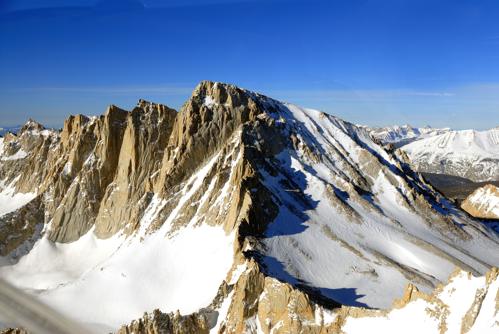 Also, be prepared for high winds, cold, and possible late afternoon thunderstorms. A hiker/climber can quickly be put into a life threatening situation if improperly prepared for bad weather.
Also, be prepared for high winds, cold, and possible late afternoon thunderstorms. A hiker/climber can quickly be put into a life threatening situation if improperly prepared for bad weather.Next, is lightening. If you detect a thunderstorm developing, vacate the summit and high ridges at once. The first recorded fatality on Mt Whitney was due to lightening.
Many inexperienced hikers come to Mt Whitney each year and try for the summit only to end up in pain and failure. As mentioned on the main Whitney page, 2 out of 3 people who attempt the summit do not make it, and an unfortunate few over the years have lost their lives. So be safe and have a great adventure. But don't take the mountain for granted. High altitude is serious business.
The following is from the US Inyo National Forest site:
By any route, climbing Mt. Whitney is difficult and potentially dangerous. Every year visitors become sick, injured; and sometimes die. Almost all illnesses, injuries and fatalities occur on Mt. Whitney's "easiest" routes, including the Mt Whitney Trail and the Mountaineers Route. Relative to the number of visitors, the number of rescue missions on Mt Whitney is disproportionately high. The following elements are recurrent factors in incidents that occur at Mt. Whitney:
- Snow and ice (significant factor in fatalities)Weather (significant factor in fatalities due to Hypothermia)
- Exhaustions and Altitude Sickness, signs and symptoms of illness are ignored (extremely common)
- Obvious hazards ignored or not recognized
- Poor judgment
- Simple stumbles and falls (many times due to exhaustion and lack of Conditioning)
Disclaimer: This is by no means a complete list of all the dangers in the mountains. Mountaineering is inherently dangerous. If you venture into the outdoors to undertake any activity, you assume all risks and responsibilities for yourself and your party. Get proper training, and go with others who are experienced. And remember, no mountain is worth your life. For a bit more on the basics of safety when Mountaineering, please check out our page on Climbing Safety Basics.
Email Sign Up
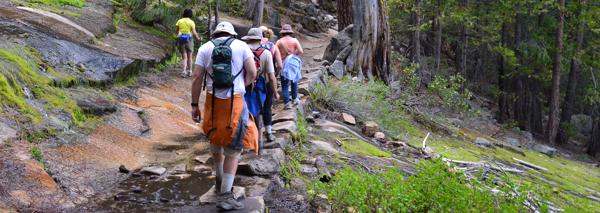
| Join the Adventure! Sign up here for Timberline Trails Monthly Newsletter |

Join us on Instagram

©2006-2024 TimberlineTrails. All Rights Reserved.
....